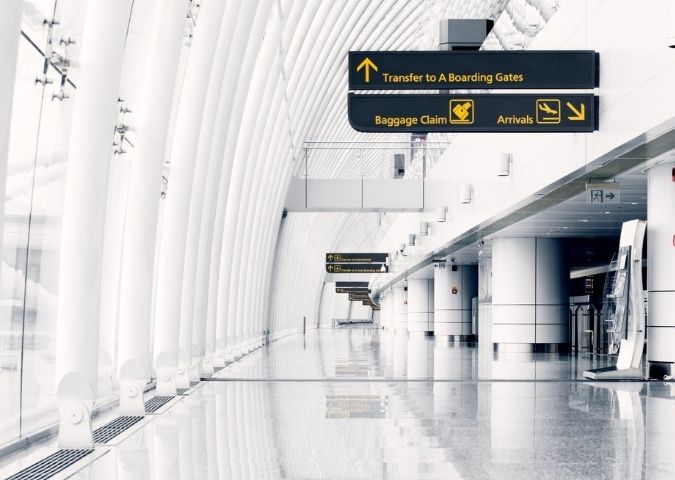Sri Lanka
For a trip to Sri Lanka, you need a valid visa. Which type is suitable for your travel plans and whether you can also enter Sri Lanka with an E-Visa depends on a number of factors. We support you in applying for your ETA for Sri Lanka.
Country facts
Do you plan a vacation in Sri Lanka? You can look forward to gorgeous beaches, tea plantations, and magnificent national parks! But before you set off for the sunny island in the Indian Ocean, check out the following travel tips.
Quick facts Sri Lanka
- Location: South Asia
- Area: 65,610 km²
- Currency: Sri Lanka Rupee (LKR)
- Official languages: Sinhala, Tamil
- Population: approx. 21.9 million
- Capital: Colombo
Climate in Sri Lanka
Sri Lanka has a tropical, hot, and humid climate that is strongly influenced by monsoons. The average temperatures are warm to hot throughout the year. However, there are differences between the central highlands, with an average temperature of 16 °C, and the coastal plains, where the thermometer climbs to 32 °C on average.
Due to its location in the region receiving monsoon winds from the Indian Ocean, Sri Lanka at times experiences very high levels of rainfall, which can cause severe flooding. The rainy season lasts from June to October in the southwest and from December to March in the northeast.
Landscape and nature in Sri Lanka
Three different landscapes prevail on the island of Sri Lanka: the lowland plains dominated by agriculture, the central highlands with mountains rising up to 2,500 m, and the coasts with their dreamy sandy beaches.
Depending on the amount of rainfall, Sri Lanka's vegetation changes from west to east. The areas in the south and west have the highest rainfall and are covered by tropical rainforests. Here, you will also find the cloud forests of the Hortons Plains National Park and the lowland rainforest of the Sinharaja National Park.
The scrub vegetation that predominates in the north and east, on the other hand, is less lush. Sri Lanka's diverse wildlife features water buffalos, langurs, sloth bears, leopards, elephants, and many more.
Entering Sri Lanka
You need an ETA or a visa to enter Sri Lanka. Also, inform yourself about the current entry requirements for Sri Lanka before your journey.
Getting around Sri Lanka
Sri Lanka's tourist areas are well connected to the state infrastructure. The most important means of public transportation is the railroad, which connects all major cities. In addition, there are public buses, but their reliability is limited due to the sometimes chaotic traffic on the roads.
Attention
Sri Lanka has left-hand traffic.
Means of payment in Sri Lanka
Credit card payment is common in the larger cities and touristy regions of Sri Lanka. However, it is advisable to always carry enough cash to pay in smaller stores or in remote regions. There are enough ATMs in cities and in tourist areas.
Otherwise, cash can only be exchanged at authorized places, banks, and hotels.
Travel and safety tips for Sri Lanka
As the local security situation in Sri Lanka can change at short notice, you should keep up to date with current events and forecasts during your trip with the help of news and the weather report.
Health informationen for Sri Lanka
Persons nine months of age and older must provide proof of yellow fever vaccination to enter Sri Lanka if they come from a yellow fever area or have had a transit of more than 12 hours within a yellow fever area. Recommended travel vaccinations for Sri Lanka include hepatitis A and B, dengue fever, typhoid, rabies and Japanese encephalitis.
Cities in Sri Lanka
As a Sri Lanka traveler, you should definitely plunge into the hustle and bustle of Colombo, where modern skyscrapers, beautiful colonial buildings, and Buddhist temples combine to form an irresistible mix. Sri Lanka's capital also has plenty of nature to offer: because of its green boulevards and landscaped gardens, it has become known as the "Garden City of the East."
The cultural center of Sri Lanka is the city of Kandy, the former capital of the ancient kings. It is located in the heart of the island on a picturesque lake and is characterized by beautiful 16th century architecture. If you want to do the entire island tour, your travel list should also include history-rich Jaffna on the Northern tip of Sri Lanka and artistic Galle, as well as the beach towns of Hikkaduwa and Unawatuna in the South.
Temples in Sri Lanka
Buddhist temples are among the most popular tourist attractions in Sri Lanka. The country's largest temple complex, the Dambulla Cave Temple, was built on a black rock that dominates the region and contains statues and paintings dating back to the 12th century. Also legendary is Sri Dalada Maligawa, the "Temple of the Tooth" in the city of Kandy. This beautiful structure is the repository of the Buddha's tooth relic, which according to tradition contains the left canine tooth of Buddha Siddhartha.
The mountain peak Mihintale, although not a temple in the strict sense, is one of the most important pilgrimage sites in the country. Sri Lankans believe that a meeting between the Buddhist monk Mahinda and King Devanampiyatissa took place here, signifying the beginning of Buddhism in Sri Lanka. Therefore, Mihintale is also known as the birthplace of Buddhism.
National parks in Sri Lanka
Udawalawe, Yala, Gal Oya, Horton Plains and more: Sri Lanka has 21 unique national parks that will take your breath away! Cross lagoons, swamplands and rainforests, watch elephants migrate and climb Sri Lanka's highest peaks!

